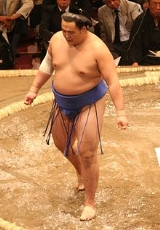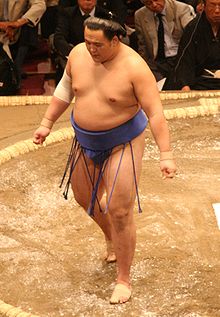
Tamawashi Ichirō
Encyclopedia
Tamawashi Ichirō born 16 November 1984 as Batjargal Munkh-Orgil, , is a professional sumo
wrestler from Ulan-Bator, Mongolia
. He made his debut in January 2004 and reached the top makuuchi
division in September 2008. His highest rank has been maegashira 3. He wrestles for Kataonami stable
.
by his older sister who was studying there. On a visit to see his sister in Japan, they went to Ryōgoku
where Tokyo's official tournaments are held. They happened to wander by Izutsu stable
and had a chance to meet the up and coming Mongolian sumo wrestler for that stable, Kakuryū. They talked about the prospects of Batjargal joining a stable and Kakuryū put him in touch with former senior Mongolian sumo wrestler Kyokushūzan. Through this connection, he was recruited by the former sekiwake Tamanofuji and joined Kataonami stable
in January 2004.
 He made steady progress through the lower divisions
He made steady progress through the lower divisions
, recording only one make-koshi on the way to the third highest makushita division in May 2005. He went up and down the division until taking the championship or yusho
in September 2007 with a perfect 7-0 record, which sent him up the ranks to Makushita 2. A 4-3 record in the next tournament was enough to earn him promotion to the elite sekitori
ranks for the January 2008 tournament.
After producing four consecutive kachi-koshi scores in the jūryō division, Tamawashi made his debut in the top makuuchi
division in September 2008. A 4-11 record sent him back to jūryō but a 10-5 score in November returned him immediately to makuuchi. His first winning score in the top division in March 2009 saw him at his highest rank to date of maegashira 8 in the May 2009 tournament. However, he could only manage a 5-10 score at maegashira 11 in July, and was demoted back to jūryō, replaced by Masatsukasa. However, he responded by taking the jūryō division championship with an 11-4 record in September, which returned him immediately to the top division. In the November 2009 tournament he produced his best top division score so far of 10-5, which saw him promoted to maegashira 7 for the January 2010 tourney. Another kachi-koshi score of 8-7 saw him promoted to a new highest rank of maegashira 4. He was however unable to defeat any of his sanyaku opponents and had slipped back to maegashira 14 by July 2010. He responded with scores of 10-5 and 9-6 in the next two tournaments, earning him promotion to his highest rank to date of maegashira 3.
Tamawashi defeated Harumafuji in the January 2011 tournament, his first victory over an ozeki, but finished with a 5-10 record. The tournament ended on an embarrassing note for him when he injured his right arm by leaning against and breaking the window of a restaurant in Tokyo. He had been on a night out drinking following the final day's action, and was given a stiff warning by the Sumo Association. The injury did not affect his participation in the next tournament, which did not take place until May. Fighting only his fellow maegashira, he scored 7-8 but remained at the same rank for the next tournament.
is overwhelmingly oshi-dashi (push out), which accounts for half his career wins. He is not comfortable fighting on the mawashi
, winning only 15 bouts by yori-kiri (force out) in his career to date.
Sumo
is a competitive full-contact sport where a wrestler attempts to force another wrestler out of a circular ring or to touch the ground with anything other than the soles of the feet. The sport originated in Japan, the only country where it is practiced professionally...
wrestler from Ulan-Bator, Mongolia
Mongolia
Mongolia is a landlocked country in East and Central Asia. It is bordered by Russia to the north and China to the south, east and west. Although Mongolia does not share a border with Kazakhstan, its western-most point is only from Kazakhstan's eastern tip. Ulan Bator, the capital and largest...
. He made his debut in January 2004 and reached the top makuuchi
Makuuchi
or is the top division of professional sumo. Its size is fixed at 42 wrestlers , ordered into five ranks according to their ability as defined by their performance in previous tournaments....
division in September 2008. His highest rank has been maegashira 3. He wrestles for Kataonami stable
Kataonami Stable
is a stable of sumo wrestlers, one of the Nishonoseki group of stables. It was founded in 1961 by former sekiwake Tamanoumi Daitaro of the Nishonoseki Stable. Former sekiwake Tamanofuji took over the running of the stable upon Tamanoumi's death in 1987. In February 2010 he passed control over to...
.
Life before and entry into sumo
In Mongolia, Batjargal was working toward a career in the hotel industry, but was encouraged to come to JapanJapan
Japan is an island nation in East Asia. Located in the Pacific Ocean, it lies to the east of the Sea of Japan, China, North Korea, South Korea and Russia, stretching from the Sea of Okhotsk in the north to the East China Sea and Taiwan in the south...
by his older sister who was studying there. On a visit to see his sister in Japan, they went to Ryōgoku
Ryogoku
is a neighborhood in Sumida, Tokyo. It is surrounded by various neighborhoods in Sumida, Chūō, and Taitō wards: Yokoami, Midori, Chitose, Higashi Nihonbashi, and Yanagibashi....
where Tokyo's official tournaments are held. They happened to wander by Izutsu stable
Izutsu stable
is a stable of sumo wrestlers, part of the Tokitsukaze group of stables.The stable was established in the Meiji era by former yokozuna Nishinoumi Kajirō I, the 16th yokozuna, who became the 7th Izutsu-oyakata. He was succeeded by Nishinoumi Kajirō II, the 25th yokozuna...
and had a chance to meet the up and coming Mongolian sumo wrestler for that stable, Kakuryū. They talked about the prospects of Batjargal joining a stable and Kakuryū put him in touch with former senior Mongolian sumo wrestler Kyokushūzan. Through this connection, he was recruited by the former sekiwake Tamanofuji and joined Kataonami stable
Kataonami Stable
is a stable of sumo wrestlers, one of the Nishonoseki group of stables. It was founded in 1961 by former sekiwake Tamanoumi Daitaro of the Nishonoseki Stable. Former sekiwake Tamanofuji took over the running of the stable upon Tamanoumi's death in 1987. In February 2010 he passed control over to...
in January 2004.
Career

Professional sumo divisions
Professional sumo is divided into 6 ranked divisions. Wrestlers are promoted and demoted within and between these divisions based on the merit of their win/loss records in official tournaments. For more information see kachikoshi and makekoshi. Wrestlers are also ranked within each division...
, recording only one make-koshi on the way to the third highest makushita division in May 2005. He went up and down the division until taking the championship or yusho
Yusho
A Yūshō is a tournament championship in sumo. It is awarded in each of the six annual honbasho or official tournaments, to the wrestler who wins the most number of bouts. Yūshō are awarded in all six professional sumo divisions...
in September 2007 with a perfect 7-0 record, which sent him up the ranks to Makushita 2. A 4-3 record in the next tournament was enough to earn him promotion to the elite sekitori
Sekitori
A sekitori is a sumo wrestler who is ranked in one of the top two professional divisions: makuuchi and juryo.Currently there are 70 rikishi in these divisions...
ranks for the January 2008 tournament.
After producing four consecutive kachi-koshi scores in the jūryō division, Tamawashi made his debut in the top makuuchi
Makuuchi
or is the top division of professional sumo. Its size is fixed at 42 wrestlers , ordered into five ranks according to their ability as defined by their performance in previous tournaments....
division in September 2008. A 4-11 record sent him back to jūryō but a 10-5 score in November returned him immediately to makuuchi. His first winning score in the top division in March 2009 saw him at his highest rank to date of maegashira 8 in the May 2009 tournament. However, he could only manage a 5-10 score at maegashira 11 in July, and was demoted back to jūryō, replaced by Masatsukasa. However, he responded by taking the jūryō division championship with an 11-4 record in September, which returned him immediately to the top division. In the November 2009 tournament he produced his best top division score so far of 10-5, which saw him promoted to maegashira 7 for the January 2010 tourney. Another kachi-koshi score of 8-7 saw him promoted to a new highest rank of maegashira 4. He was however unable to defeat any of his sanyaku opponents and had slipped back to maegashira 14 by July 2010. He responded with scores of 10-5 and 9-6 in the next two tournaments, earning him promotion to his highest rank to date of maegashira 3.
Tamawashi defeated Harumafuji in the January 2011 tournament, his first victory over an ozeki, but finished with a 5-10 record. The tournament ended on an embarrassing note for him when he injured his right arm by leaning against and breaking the window of a restaurant in Tokyo. He had been on a night out drinking following the final day's action, and was given a stiff warning by the Sumo Association. The injury did not affect his participation in the next tournament, which did not take place until May. Fighting only his fellow maegashira, he scored 7-8 but remained at the same rank for the next tournament.
Fighting style
Unusually for a Mongolian wrestler Tamawashi is an oshi-sumo specialist, who prefers pushing and thrusting techniques. His most common winning kimariteKimarite
Kimarite are winning techniques in a sumo bout. For each bout in a Grand Sumo tournament , a sumo referee, or gyoji, will decide and announce the type of kimarite used by the winner...
is overwhelmingly oshi-dashi (push out), which accounts for half his career wins. He is not comfortable fighting on the mawashi
Mawashi
In sumo, a mawashi is the belt that the rikishi wears during training or in competition. Upper ranked professional wrestlers wear a keshō-mawashi as part of the ring entry ceremony or dohyo-iri.-Mawashi:...
, winning only 15 bouts by yori-kiri (force out) in his career to date.

